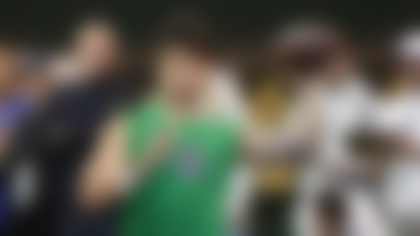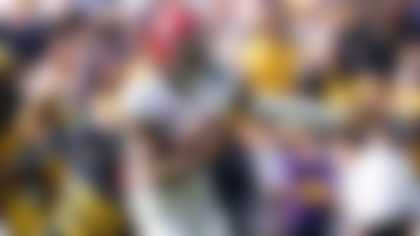By Bill Bradley, contributing editor
The NFL, in association with Under Armour and General Electric, on Thursday announced the seven winners of $500,000 brain research grants in the Head Health Challenge II. The winners are eligible to receive up to $8.5 million to accelerate brain injury research, diagnosis and protection.
The winners, which include researchers from the public and private sectors, were selected among nearly 500 proposals that were submitted between Sept. 2013 and Feb. 2014 from 19 countries.
NFL, Under Armour and GE will monitor the progress of the initiatives during the next year. Each award winner will receive $500,000 and will also have the opportunity to receive an additional $1 million to advance their work to better protect against brain injury. The disruptive ideas introduced by these seven entries are designed to increase brain safety for athletes, members of the armed forces and society at-large. The stories behind the winning entries and their pioneering efforts in this field are showcased in seven short online videos available to watch at www.headhealthchallenge.com.
"Each of these seven winners will help advance the science towards our shared goal of making sports safer," NFL Commissioner Roger Goodell said in a statement. "New materials, equipment designs and technology breakthroughs will better protect athletes, no matter what sport they play. We are looking forward to supporting their next stages of development."
The open innovation challenge is part of the multi-year collaboration among Under Armour, GE and the NFL called the Head Health Initiative. Launched in March 2013, the initiative includes a four-year, $40 million research and development program from the NFL and GE to evaluate and develop next-generation imaging technologies to improve diagnosis, which would allow for targeting treatment therapy for patients with mild traumatic brain injury.
The two open innovation challenges will provide as much as $20 million in research and technology development to better understand, diagnose and protect against brain injury.
"By partnering with the NFL and GE, we have created a dynamic forum with the Head Health Challenge II that energizes people to join our pursuit of breakthrough solutions and empowers these innovators with substantial financial support to fund their ideas," said Under Armour founder and CEO Kevin Plank.
The backstories of the Challenge II winning entries can be viewed here.
The Challenge award-winners are:
Army Research Laboratory, Baltimore, Maryland: The laboratory created rate-dependent tethers that allow free motion at low speeds but provide high force resistance during high-speed events. ARL proposes using these smart materials to connect the head to the torso, allowing voluntary head movement during sports action while minimizing sudden accelerations caused by high-speed collisions, often associated with concussions. Beyond sports, this technology also might mitigate head trauma for members of the military.
Emory University, Atlanta: Researchers and engineers from Emory and Georgia Tech developed a prototype medical device that can screen and assess concussions in near-real time. The portable device, known as iDETECT, can be used on the sidelines of sporting events. It consists of a headset and handheld device that rapidly assesses the player's symptoms, including cognitive function, balance and eye movements.
UCLA, Los Angeles: UCLA and Architected Materials, Inc., are developing a new energy-absorbing micro-lattice material for improved helmet performance. The material would be used as a new under-helmet liner, which would absorb significantly more energy than current designs and better protect the brain. Through a collaboration of material designers, mechanical impact experts and neuroscientists, they would utilize a new 3-D printing platform to develop real-time responsive helmet technology.
University of Miami (Florida), Coral Gables, Florida: The University's Miller School of Medicine, in collaboration with the University of Pittsburgh School of Medicine, is developing a portable eye goggle that has the ability to gather and measure precise eye movements. The goggle would assist in identifying mild traumatic brain injury in real time, leading to more accurate concussion diagnosis. This advanced research into traumatic brain injuries began in the U.S. military at the Army Medical Research and Materials Command and the Department of Defense Hearing Center of Excellence.
University of Washington, Seattle: University researchers are developing a football helmet with commercial partner VICIS, Inc. The helmet boasts a novel impact-absorbing structure and materials that would better protect against head injuries. The UW and VICIS team includes thought-leading engineers and neurosurgeons, public health experts and business leaders committed to using science to elevate athlete performances.
Viconic, Inc., Detroit: Viconic's research has focused on developing an under-layer for synthetic turf systems that would make fields safer. Viconic would further explore the relationship between optimized head impact protection and the frequency of lower limb injuries in an effort to provide the synthetic turf industry a tool to specify systems that maximize player safety and minimize system costs.
University of New Hampshire, Durham, New Hampshire: University researcher Erik Swartz will lead a study to evaluate the effectiveness of a helmet-less tackling training system called the HuTTTM Technique. Proposed as an intervention for head impact prevention in high school football, this technique would emphasize proper tackling and blocking technique using closely supervised drills in which players participate without their helmets and shoulder pads. UNH will investigate whether regular implementation of the HuTTTM technique results in player behavior change and reduces injury risk by reinforcing proper technique when players go into full-equipment play.
For more information about the Head Health Challenge, including information on the Challenge II judges, visit www.headhealthchallenge.com.



